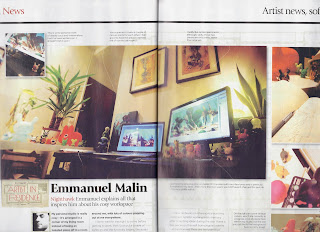Blog Archive
About Me

- John
- Birmingham, West Midlands, United Kingdom
- Aspiring illustrator for the computer games industry. Currently Studying Visual Communication at the Birmingham Institute of Art and Design
Tuesday, 11 January 2011
 environment and ideational fluency
environment and ideational fluency
02:02 | Posted by
John |
Edit Post

An illustrator should always be able to adapt to their surroundings and gain inspiration from them. This enforces the importance of reportage illustration as different surroundings lead to different outcomes it is almost inevitable. Managing a creative environment is important; it’s much more than a workspace, which provides ample room to work, it should be personal to the artist and inspire them as individuals. As shown above, Emmanuel Malin states ‘I really enjoy my workstation being a part of my living space...all of this helps me to relax, and I have my designer toys around me, with lots of colour popping out at me everywhere.’ This clearly supports what I have previously suggested. Objects, individuals, music, television, all of these help stimulate Malin’s workflow and allow him to flourish. This should be related to the artist or illustrator as individuals. For example, I personally find music a great inspiration; the mood of the melody has been known to come out in my work. This may be a subconscious development but a brilliant development at that. When evaluating and reviewing my own ideas, I like to have a clean work space in order to do so effectively and accurately, as any illustrator will concur when engrossed in a project, the workspace becomes visually cluttered reflecting the progress and growth of my initial work.
Developing ideational fluency.
When one is working on a project, the development of ideation and the rate at which it is achieved is fundamental to the success of the final project. Ideational fluency refers to the pace in which ideas are grounded and can thus be developed. It is crucial that an artist’s ideas are of sufficient quantity and are diverse enough to be purified and sculpted into a relevant direction. It is essential for this to be given the correct amount of attention in order for certain pieces of work to be perfected which lead to the further development of ideation. Certain tools can be essential for the success of this process; methods such as mind mapping and brainstorming can lead an artist into a specific mind frame which thus leads an artist into the afore mentioned direction which the development of ideational fluency strives to achieve. Here is an example of my personal development of ideational fluency:
Subscribe to:
Post Comments (Atom)
0 comments:
Post a Comment